Rational Expressions and Functions
Solve Rational Inequalities
Learning Objectives
By the end of this section, you will be able to:
- Solve rational inequalities
- Solve an inequality with rational functions
Before you get started, take this readiness quiz.
Solve Rational Inequalities
We learned to solve linear inequalities after learning to solve linear equations. The techniques were very much the same with one major exception. When we multiplied or divided by a negative number, the inequality sign reversed.
Having just learned to solve rational equations we are now ready to solve rational inequalities. A rational inequality is an inequality that contains a rational expression.
A rational inequality is an inequality that contains a rational expression.
Inequalities such as ![]() and
and ![]() are rational inequalities as they each contain a rational expression.
are rational inequalities as they each contain a rational expression.
When we solve a rational inequality, we will use many of the techniques we used solving linear inequalities. We especially must remember that when we multiply or divide by a negative number, the inequality sign must reverse.
Another difference is that we must carefully consider what value might make the rational expression undefined and so must be excluded.
When we solve an equation and the result is ![]() we know there is one solution, which is 3.
we know there is one solution, which is 3.
When we solve an inequality and the result is ![]() we know there are many solutions. We graph the result to better help show all the solutions, and we start with 3. Three becomes a critical point and then we decide whether to shade to the left or right of it. The numbers to the right of 3 are larger than 3, so we shade to the right.
we know there are many solutions. We graph the result to better help show all the solutions, and we start with 3. Three becomes a critical point and then we decide whether to shade to the left or right of it. The numbers to the right of 3 are larger than 3, so we shade to the right.

To solve a rational inequality, we first must write the inequality with only one quotient on the left and 0 on the right.
Next we determine the critical points to use to divide the number line into intervals. A critical point is a number which make the rational expression zero or undefined.
We then will evaluate the factors of the numerator and denominator, and find the quotient in each interval. This will identify the interval, or intervals, that contains all the solutions of the rational inequality.
We write the solution in interval notation being careful to determine whether the endpoints are included.
Solve and write the solution in interval notation: ![]()
Step 1. Write the inequality as one quotient on the left and zero on the right.
Our inequality is in this form. ![]()
Step 2. Determine the critical points—the points where the rational expression will be zero or undefined.
The rational expression will be zero when the numerator is zero. Since ![]() when
when ![]() then
then ![]() is a critical point.
is a critical point.
The rational expression will be undefined when the denominator is zero. Since ![]() when
when ![]() then
then ![]() is a critical point.
is a critical point.
The critical points are 1 and ![]()
Step 3. Use the critical points to divide the number line into intervals.

The number line is divided into three intervals:
![]()
Step 4. Test a value in each interval. Above the number line show the sign of each factor of the rational expression in each interval. Below the number line show the sign of the quotient.
To find the sign of each factor in an interval, we choose any point in that interval and use it as a test point. Any point in the interval will give the expression the same sign, so we can choose any point in the interval.
The number ![]() is in the interval
is in the interval ![]() Test
Test ![]() in the expression in the numerator and the denominator.
in the expression in the numerator and the denominator.

Above the number line, mark the factor ![]() negative and mark the factor
negative and mark the factor ![]() negative.
negative.
Since a negative divided by a negative is positive, mark the quotient positive in the interval ![]()

The number 0 is in the interval ![]() Test
Test ![]()

Above the number line, mark the factor ![]() negative and mark
negative and mark ![]() positive.
positive.
Since a negative divided by a positive is negative, the quotient is marked negative in the interval ![]()

The number 2 is in the interval ![]() Test
Test ![]()

Above the number line, mark the factor ![]() positive and mark
positive and mark ![]() positive.
positive.
Since a positive divided by a positive is positive, mark the quotient positive in the interval ![]()

Step 5. Determine the intervals where the inequality is correct. Write the solution in interval notation.
We want the quotient to be greater than or equal to zero, so the numbers in the intervals ![]() and
and ![]() are solutions.
are solutions.
But what about the critical points?
The critical point ![]() makes the denominator 0, so it must be excluded from the solution and we mark it with a parenthesis.
makes the denominator 0, so it must be excluded from the solution and we mark it with a parenthesis.
The critical point ![]() makes the whole rational expression 0. The inequality requires that the rational expression be greater than or equal to. So, 1 is part of the solution and we will mark it with a bracket.
makes the whole rational expression 0. The inequality requires that the rational expression be greater than or equal to. So, 1 is part of the solution and we will mark it with a bracket.

Recall that when we have a solution made up of more than one interval we use the union symbol, ![]() to connect the two intervals. The solution in interval notation is
to connect the two intervals. The solution in interval notation is ![]()
Solve and write the solution in interval notation: ![]()
![]()
Solve and write the solution in interval notation: ![]()
![]()
We summarize the steps for easy reference.
- Write the inequality as one quotient on the left and zero on the right.
- Determine the critical points–the points where the rational expression will be zero or undefined.
- Use the critical points to divide the number line into intervals.
- Test a value in each interval. Above the number line show the sign of each factor of the numerator and denominator in each interval. Below the number line show the sign of the quotient.
- Determine the intervals where the inequality is correct. Write the solution in interval notation.
The next example requires that we first get the rational inequality into the correct form.
Solve and write the solution in interval notation: ![]()
| Subtract 1 to get zero on the right. | ||
| Rewrite 1 as a fraction using the LCD. | ||
| Subtract the numerators and place the
difference over the common denominator. |
||
| Simplify. | ||
| Factor the numerator to show all factors. | ||
| Find the critical points. | ||
| The quotient will be zero when the numerator is zero.
The quotient is undefined when the denominator is zero. |
||
| Use the critical points to divide the number line into intervals. | ||
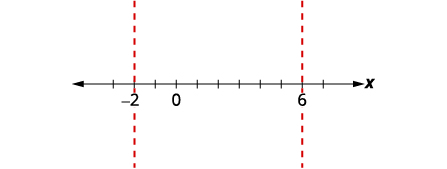 |
||
| Test a value in each interval. | ||
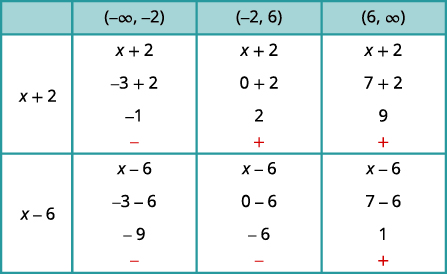 |
||
| Above the number line show the sign of each factor of the rational expression in each interval.
Below the number line show the sign of the quotient. |
||
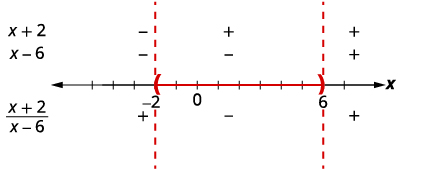 |
||
| Determine the intervals where the inequality is correct. We want the quotient to be negative, so the solution includes the points between −2 and 6. Since the inequality is strictly less than, the endpoints are not included. | ||
| We write the solution in interval notation as (−2, 6). | ||
Solve and write the solution in interval notation: ![]()
![]()
Solve and write the solution in interval notation: ![]()
![]()
In the next example, the numerator is always positive, so the sign of the rational expression depends on the sign of the denominator.
Solve and write the solution in interval notation: ![]()
| The inequality is in the correct form. | |
| Factor the denominator. | |
| Find the critical points.
The quotient is 0 when the numerator is 0. Since the numerator is always 5, the quotient cannot be 0. |
|
| The quotient will be undefined when the
denominator is zero. |
|
| Use the critical points to divide the number line into intervals. | |
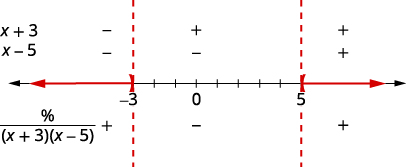 |
|
| Test values in each interval.
Above the number line show the sign of each factor of the denominator in each interval. Below the number line, show the sign of the quotient. |
|
| Write the solution in interval notation. | |
Solve and write the solution in interval notation: ![]()
![]()
Solve and write the solution in interval notation: ![]()
![]()
The next example requires some work to get it into the needed form.
Solve and write the solution in interval notation: ![]()
| Subtract |
||
| Rewrite to get each fraction with the LCD |
||
| Simplify. | ||
| Subtract the numerators and place the
difference over the common denominator. |
||
| Factor the numerator. | ||
| Find the critical points. | ||
| Use the critical points to divide the number
line into intervals. |
||
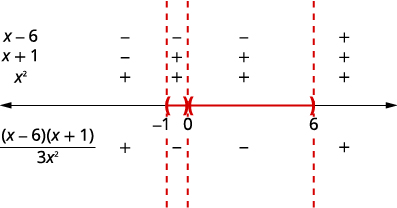 |
||
| Above the number line show the sign of each
factor in each interval. Below the number line, show the sign of the quotient. |
||
| Since, 0 is excluded, the solution is the two
intervals, |
||
Solve and write the solution in interval notation: ![]()
![]()
Solve and write the solution in interval notation: ![]()
![]()
Solve an Inequality with Rational Functions
When working with rational functions, it is sometimes useful to know when the function is greater than or less than a particular value. This leads to a rational inequality.
Given the function ![]() find the values of x that make the function less than or equal to 0.
find the values of x that make the function less than or equal to 0.
We want the function to be less than or equal to 0.
| Substitute the rational expression for |
|
| Find the critical points. | |
| Use the critical points to divide the number line into intervals. | |
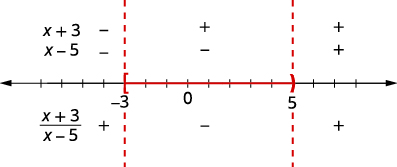 |
|
| Test values in each interval. Above the
number line, show the sign of each factor in each interval. Below the number line, show the sign of the quotient |
|
| Write the solution in interval notation. Since
5 is excluded we, do not include it in the interval. |
|
Given the function ![]() find the values of x that make the function less than or equal to 0.
find the values of x that make the function less than or equal to 0.
![]()
Given the function ![]() find the values of x that make the function less than or equal to 0.
find the values of x that make the function less than or equal to 0.
![]()
In economics, the function ![]() is used to represent the cost of producing x units of a commodity. The average cost per unit can be found by dividing
is used to represent the cost of producing x units of a commodity. The average cost per unit can be found by dividing ![]() by the number of items
by the number of items ![]() Then, the average cost per unit is
Then, the average cost per unit is ![]()
The function ![]() represents the cost to produce
represents the cost to produce ![]() number of items. Find ⓐ the average cost function,
number of items. Find ⓐ the average cost function, ![]() ⓑ how many items should be produced so that the average cost is less than ?40.
ⓑ how many items should be produced so that the average cost is less than ?40.
ⓐ

ⓑ
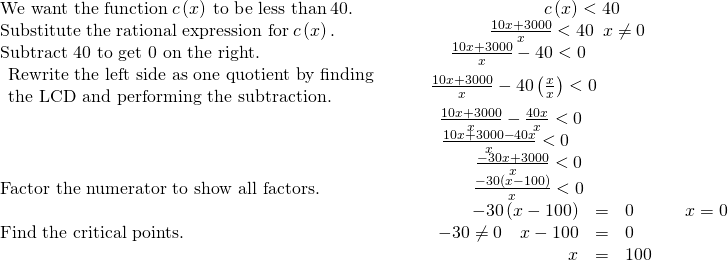
More than 100 items must be produced to keep the average cost below ?40 per item.
The function ![]() represents the cost to produce
represents the cost to produce ![]() number of items. Find ⓐ the average cost function,
number of items. Find ⓐ the average cost function, ![]() ⓑ how many items should be produced so that the average cost is less than ?60?
ⓑ how many items should be produced so that the average cost is less than ?60?
ⓐ![]()
ⓑ More than 150 items must be produced to keep the average cost below ?60 per item.
The function ![]() represents the cost to produce
represents the cost to produce ![]() number of items. Find ⓐ the average cost function,
number of items. Find ⓐ the average cost function, ![]() ⓑ how many items should be produced so that the average cost is less than ?20?
ⓑ how many items should be produced so that the average cost is less than ?20?
ⓐ![]() ⓑ More than 60 items must be produced to keep the average cost below ?20 per item.
ⓑ More than 60 items must be produced to keep the average cost below ?20 per item.
Key Concepts
- Solve a rational inequality.
- Write the inequality as one quotient on the left and zero on the right.
- Determine the critical points–the points where the rational expression will be zero or undefined.
- Use the critical points to divide the number line into intervals.
- Test a value in each interval. Above the number line show the sign of each factor of the rational expression in each interval. Below the number line show the sign of the quotient.
- Determine the intervals where the inequality is correct. Write the solution in interval notation.
Section Exercises
Practice Makes Perfect
Solve Rational Inequalities
In the following exercises, solve each rational inequality and write the solution in interval notation.
![]()
![]()
![]()
![]()
![]()
![]()
![]()
![]()
![]()
![]()
![]()
![]()
![]()
![]()
![]()
![]()
![]()
![]()
![]()
![]()
![]()
![]()
![]()
![]()
![]()
![]()
![]()
![]()
![]()
![]()
![]()
![]()
![]()
![]()
![]()
![]()
![]()
![]()
![]()
![]()
![]()
![]()
![]()
![]()
![]()
![]()
![]()
![]()
Solve an Inequality with Rational Functions
In the following exercises, solve each rational function inequality and write the solution in interval notation.
Given the function ![]() find the values of
find the values of ![]() that make the function less than or equal to 0.
that make the function less than or equal to 0.
![]()
Given the function ![]() find the values of
find the values of ![]() that make the function less than or equal to 0.
that make the function less than or equal to 0.
Given the function ![]() , find the values of x that make the function less than or equal to 0.
, find the values of x that make the function less than or equal to 0.
![]()
Given the function ![]() find the values of x that make the function less than or equal to 0.
find the values of x that make the function less than or equal to 0.
Writing Exercises
Write the steps you would use to explain solving rational inequalities to your little brother.
Answers will vary.
Create a rational inequality whose solution is ![]()
Self Check
ⓐ After completing the exercises, use this checklist to evaluate your mastery of the objectives of this section.

ⓑ After reviewing this checklist, what will you do to become confident for all objectives?
Chapter Review Exercises
Simplify, Multiply, and Divide Rational Expressions
Determine the Values for Which a Rational Expression is Undefined
In the following exercises, determine the values for which the rational expression is undefined.
![]()
![]()
![]()
![]()
![]()
![]()
Simplify Rational Expressions
In the following exercises, simplify.
![]()
![]()
![]()
![]()
![]()
![]()
Multiply Rational Expressions
In the following exercises, multiply.
![]()
![]()
![]()
![]()
![]()
![]()
Divide Rational Expressions
In the following exercises, divide.
![]()
![]()
![]()
![]()
![]()
![]()
![]()
![]()
![]()
Multiply and Divide Rational Functions
Find ![]() where
where ![]() and
and ![]()
![]()
Find ![]() where
where ![]() and
and
![]()
Add and Subtract Rational Expressions
Add and Subtract Rational Expressions with a Common Denominator
In the following exercises, perform the indicated operations.
![]()
![]()
![]()
![]()
![]()
![]()
![]()
![]()
![]()
![]()
![]()
![]()
Add and Subtract Rational Expressions Whose Denominators Are Opposites
In the following exercises, add and subtract.
![]()
![]()
![]()
![]()
![]()
![]()
Find the Least Common Denominator of Rational Expressions
In the following exercises, find the LCD.
![]()
![]()
![]()
![]()
![]()
Add and Subtract Rational Expressions with Unlike Denominators
In the following exercises, perform the indicated operations.
![]()
![]()
![]()
![]()
![]()
![]()
![]()
![]()
![]()
![]()
![]()
![]()
![]()
![]()
![]()
![]()
Add and Subtract Rational Functions
In the following exercises, find ![]() where
where ![]() and
and ![]() are given.
are given.
![]()
![]()
![]()
![]()
![]()
In the following exercises, find ![]() where
where ![]() and
and ![]() are given.
are given.
![]()
![]()
![]()
![]()
![]()
Simplify Complex Rational Expressions
Simplify a Complex Rational Expression by Writing It as Division
In the following exercises, simplify.
![]()
![]()
![]()
![]()
![]()
![]()
Simplify a Complex Rational Expression by Using the LCD
In the following exercises, simplify.
![]()
![]()
![]()
![]()
![]()
![]()
7.4 Solve Rational Equations
Solve Rational Equations
In the following exercises, solve.
![]()
![]()
![]()
![]()
![]()
![]()
![]()
no solution
![]()
Solve Rational Equations that Involve Functions
For rational function, ![]() ⓐ find the domain of the function ⓑ solve
ⓐ find the domain of the function ⓑ solve ![]() ⓒ find the points on the graph at this function value.
ⓒ find the points on the graph at this function value.
ⓐ The domain is all real numbers except ![]() and
and ![]() ⓑ
ⓑ ![]()
ⓒ ![]()
For rational function, ![]() ⓐ find the domain of the function ⓑ solve
ⓐ find the domain of the function ⓑ solve ![]() ⓒ find the points on the graph at this function value.
ⓒ find the points on the graph at this function value.
Solve a Rational Equation for a Specific Variable
In the following exercises, solve for the indicated variable.
![]() for
for ![]()
![]()
![]() for
for ![]()
![]() for
for ![]()
![]()
![]() for
for ![]()
Solve Applications with Rational Equations
Solve Proportions
In the following exercises, solve.
![]()
![]()
![]()
![]()
![]()
![]()
Solve Using Proportions
In the following exercises, solve.
Rachael had a 21-ounce strawberry shake that has 739 calories. How many calories are there in a 32-ounce shake?
![]() calories
calories
Leo went to Mexico over Christmas break and changed ?525 dollars into Mexican pesos. At that time, the exchange rate had ?1 US is equal to 16.25 Mexican pesos. How many Mexican pesos did he get for his trip?
Solve Similar Figure Applications
In the following exercises, solve.
![]() is similar to
is similar to ![]() The lengths of two sides of each triangle are given in the figure. Find the lengths of the third sides.
The lengths of two sides of each triangle are given in the figure. Find the lengths of the third sides.
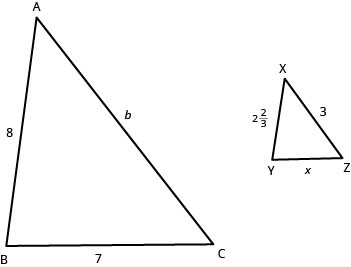
![]()
On a map of Europe, Paris, Rome, and Vienna form a triangle whose sides are shown in the figure below. If the actual distance from Rome to Vienna is 700 miles, find the distance from
ⓐ Paris to Rome
ⓑ Paris to Vienna
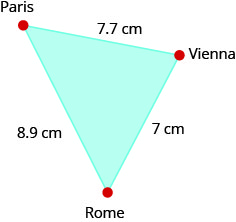
Francesca is 5.75 feet tall. Late one afternoon, her shadow was 8 feet long. At the same time, the shadow of a nearby tree was 32 feet long. Find the height of the tree.
23 feet
The height of a lighthouse in Pensacola, Florida is 150 feet. Standing next to the statue, 5.5-foot-tall Natasha cast a 1.1-foot shadow. How long would the shadow of the lighthouse be?
Solve Uniform Motion Applications
In the following exercises, solve.
When making the 5-hour drive home from visiting her parents, Lolo ran into bad weather. She was able to drive 176 miles while the weather was good, but then driving 10 mph slower, went 81 miles when it turned bad. How fast did she drive when the weather was bad?
![]() mph
mph
Mark is riding on a plane that can fly 490 miles with a tailwind of 20 mph in the same time that it can fly 350 miles against a tailwind of 20 mph. What is the speed of the plane?
Josue can ride his bicycle 8 mph faster than Arjun can ride his bike. It takes Luke 3 hours longer than Josue to ride 48 miles. How fast can John ride his bike?
![]() mph
mph
Curtis was training for a triathlon. He ran 8 kilometers and biked 32 kilometers in a total of 3 hours. His running speed was 8 kilometers per hour less than his biking speed. What was his running speed?
Solve Work Applications
In the following exercises, solve.
Brandy can frame a room in 1 hour, while Jake takes 4 hours. How long could they frame a room working together?
![]() hour
hour
Prem takes 3 hours to mow the lawn while her cousin, Barb, takes 2 hours. How long will it take them working together?
Jeffrey can paint a house in 6 days, but if he gets a helper he can do it in 4 days. How long would it take the helper to paint the house alone?
![]() days
days
Marta and Deb work together writing a book that takes them 90 days. If Sue worked alone it would take her 120 days. How long would it take Deb to write the book alone?
Solve Direct Variation Problems
In the following exercises, solve.
If ![]() varies directly as
varies directly as ![]() when
when ![]() and
and ![]() find
find ![]() when
when ![]()
![]()
If ![]() varies inversely as
varies inversely as ![]() when
when ![]() and
and ![]() find
find ![]() when
when ![]()
Vanessa is traveling to see her fiancé. The distance, ![]() varies directly with the speed,
varies directly with the speed, ![]() she drives. If she travels 258 miles driving 60 mph, how far would she travel going 70 mph?
she drives. If she travels 258 miles driving 60 mph, how far would she travel going 70 mph?
![]() mph
mph
If the cost of a pizza varies directly with its diameter, and if an 8” diameter pizza costs ?12, how much would a 6” diameter pizza cost?
The distance to stop a car varies directly with the square of its speed. It takes 200 feet to stop a car going 50 mph. How many feet would it take to stop a car going 60 mph?
![]() feet
feet
Solve Inverse Variation Problems
In the following exercises, solve.
If ![]() varies inversely with the square of
varies inversely with the square of ![]() when
when ![]() and
and ![]() find
find ![]() when
when ![]()
The number of tickets for a music fundraiser varies inversely with the price of the tickets. If Madelyn has just enough money to purchase 12 tickets for ?6, how many tickets can Madelyn afford to buy if the price increased to ?8?
![]() tickets
tickets
On a string instrument, the length of a string varies inversely with the frequency of its vibrations. If an 11-inch string on a violin has a frequency of 360 cycles per second, what frequency does a 12-inch string have?
Solve Rational Inequalities
Solve Rational Inequalities
In the following exercises, solve each rational inequality and write the solution in interval notation.
![]()
![]()
![]()
![]()
![]()
![]()
![]()
![]()
![]()
Solve an Inequality with Rational Functions
In the following exercises, solve each rational function inequality and write the solution in interval notation
Given the function, ![]() find the values of
find the values of ![]() that make the function greater than or equal to 0.
that make the function greater than or equal to 0.
![]()
Given the function, ![]() find the values of
find the values of ![]() that make the function less than or equal to 0.
that make the function less than or equal to 0.
The function
![]() represents the cost to produce
represents the cost to produce ![]() number of items. Find ⓐ the average cost function,
number of items. Find ⓐ the average cost function, ![]() ⓑ how many items should be produced so that the average cost is less than ?160.
ⓑ how many items should be produced so that the average cost is less than ?160.
ⓐ![]()
ⓑ More than 10,000 items must be produced to keep the average cost below ![]() per item.
per item.
Tillman is starting his own business by selling tacos at the beach. Accounting for the cost of his food truck and ingredients for the tacos, the function ![]() represents the cost for Tillman to produce
represents the cost for Tillman to produce ![]() tacos. Find ⓐ the average cost function,
tacos. Find ⓐ the average cost function, ![]() for Tillman’s Tacos ⓑ how many tacos should Tillman produce so that the average cost is less than ?4.
for Tillman’s Tacos ⓑ how many tacos should Tillman produce so that the average cost is less than ?4.
Practice Test
In the following exercises, simplify.
![]()
![]()
![]()
In the following exercises, perform the indicated operation and simplify.
![]()
![]()
![]()
![]()
![]()
![]()
![]()
![]()
![]()
![]()
![]()
In the following exercises, solve each equation.
![]()
![]()
![]()
![]()
In the following exercises, solve each rational inequality and write the solution in interval notation.
![]()
![]()
![]()
![]()
![]()
In the following exercises, find ![]() given
given ![]() and
and ![]()
![]()
![]()
![]()
![]()
Given the function,
![]() find the values of
find the values of ![]() that make the function less than or equal to 0.
that make the function less than or equal to 0.
![]()
In the following exercises, solve.
If ![]() varies directly with
varies directly with ![]() , and
, and ![]() when
when ![]() find
find ![]() when
when ![]()
If ![]() varies inversely with the square of
varies inversely with the square of ![]() and
and ![]() when
when ![]() find
find ![]() when
when ![]()
![]()
Matheus can ride his bike for 30 miles with the wind in the same amount of time that he can go 21 miles against the wind. If the wind’s speed is 6 mph, what is Matheus’ speed on his bike?
Oliver can split a truckload of logs in 8 hours, but working with his dad they can get it done in 3 hours. How long would it take Oliver’s dad working alone to split the logs?
Oliver’s dad would take ![]() hours to split the logs himself.
hours to split the logs himself.
The volume of a gas in a container varies inversely with the pressure on the gas. If a container of nitrogen has a volume of 29.5 liters with 2000 psi, what is the volume if the tank has a 14.7 psi rating? Round to the nearest whole number.
The cities of Dayton, Columbus, and Cincinnati form a triangle in southern Ohio. The diagram gives the map distances between these cities in inches.

The actual distance from Dayton to Cincinnati is 48 miles. What is the actual distance between Dayton and Columbus?
The distance between Dayton and Columbus is 64 miles.
Glossary
- critical point of a rational inequality
- The critical point of a rational inequality is a number which makes the rational expression zero or undefined.
- rational inequality
- A rational inequality is an inequality that contains a rational expression.

